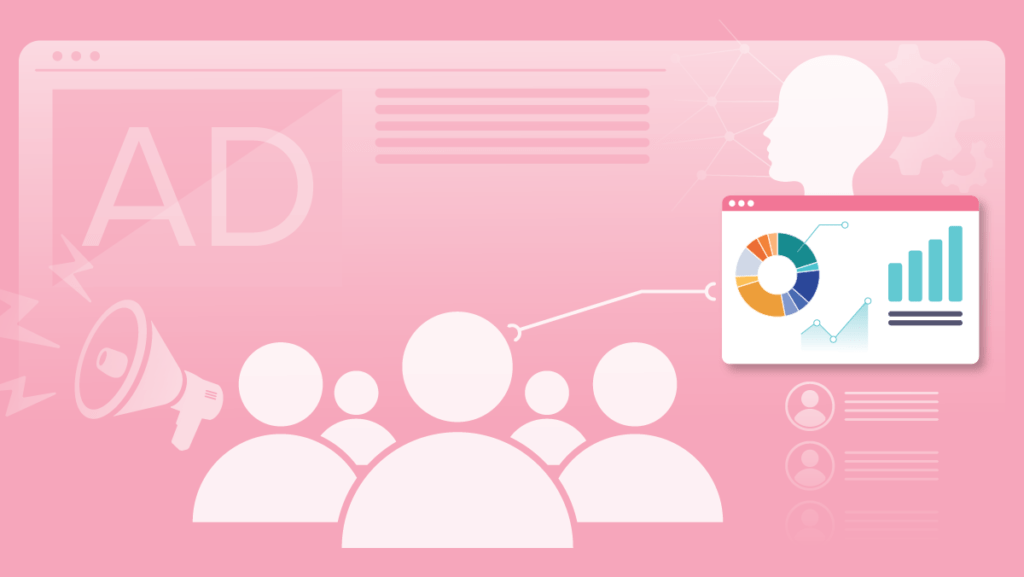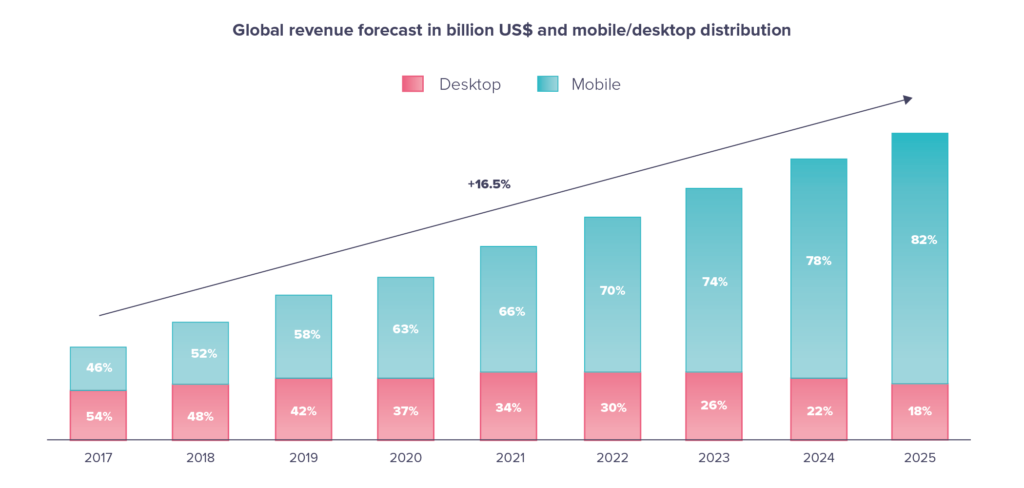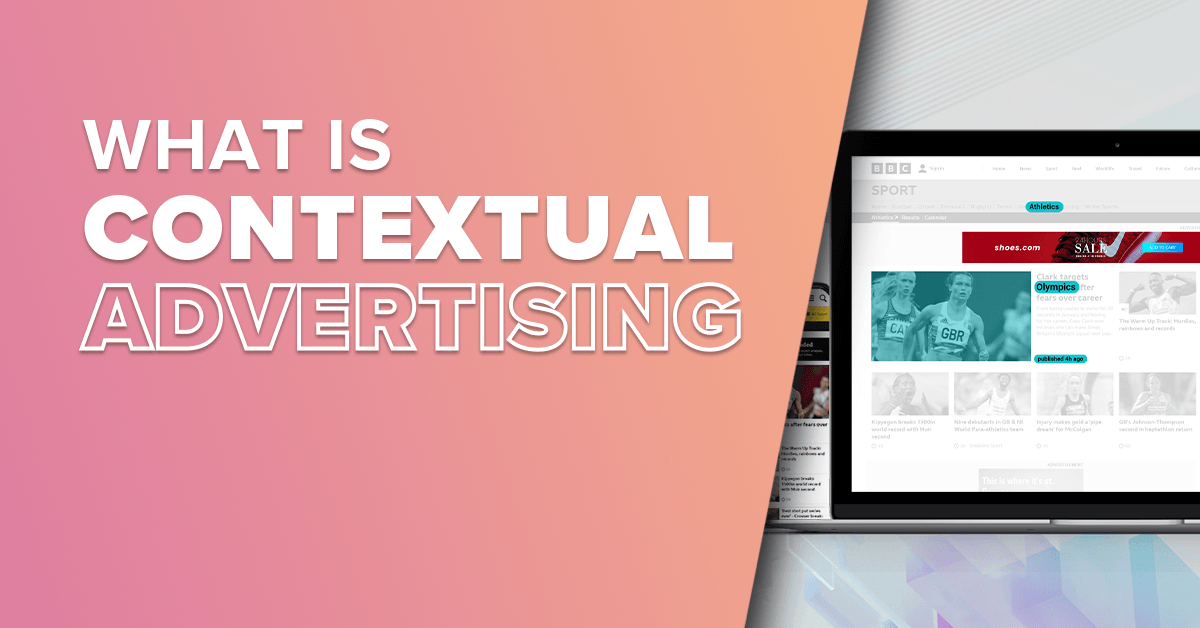The Top 6 Digital Marketing Trends of 2022
January 13, 2022
More marketers than ever spent part of their budget in digital advertising in 2021.
So what’s next? And what do you need to know to stay ahead in the rapidly growing channel?
Our team of experts have looked at millions of campaign data points from 2021 and found the top 6 digital marketing and programmatic advertising trends that you need to know about for 2022.
First, let’s take a look at how the programmatic channel works…

Content
How Programmatic Works: The Basics
Programmatic advertising has been around since the early 2000s, but it wasn’t until much later that it became mainstream. Since its birth, programmatic has grown into a $155 billion industry.
The first thing we’ll do in this section is to break down how programmatic ads work.

So, WTF is Programmatic?
Instead of humans negotiating ad rates for each individual impression, programmatic technology uses AI and machine learning to set an automated bidding strategy.
This makes it easier for brands to show ads to their specific target audience in scale.
Programmatic ad-tech for SMB’s is a rapidly rising trend in the advertising industry. It’s opening up a whole new dimension that’s previously been largely inaccessible for SMB companies.
Learn all you need to know about programmatic advertising in our guide to programmatic!
How much does Programmatic cost?
The programmatic buying process is typically traded on a CPM basis, a term in online advertising defining cost per 1,000 ad impressions.
CPMs can range wildly based on the quality of the list and the level of targeting.
The higher the quality of inventory, or the more specific you want to be in your targeting, the higher the price.
Prices also vary by industry, device, format, and placement on the page.
On average, programmatic display CPMs range from around $0.50 to $2 CPM.
This is a huge cost benefit compared to human-driven trading, which normally sees prices around $10+.
That’s x5 the price!
So, programmatic campaigns and real-time bidding can help you stretch your limited ad budgets 10 to 20 times further.
2022 Advertising Trends
How much money will programmatic advertising generate in 2022? What should you expect?
Programmatic media buying has grown at an exponential rate since its inception in the mid-2000’s.
Today, programmatic ad spend accounts for just over 80% of all digital marketing budgets globally.

This massive growth isn’t slowing down anytime soon. Programmatic advertising spending is predicted to grow another 16% in 2022.
With such high growth rates, it’s no wonder why most companies are investing heavily in programmatic advertising.
Programmatic has become a crowded space and there are many different ways to implement it to your marketing mix.
As the industry continues to mature, we’re seeing new opportunities emerge and old ones fade away.
We took a look back at some of the trends that have shaped programmatic over the past few years and what lies ahead for the future of this increasingly important form of online advertising.
To give you a head-start in 2022, the Match2One team has collected the top 6 trends you need to know about.
What you need to look out for in 2022
We’ve compiled a list of some of the top programmatic trends for 2022.
These include the latest innovations in artificial intelligence, key programmatic strategies, and formats.
Here are 6 key areas that are expected to shape the way brands market their businesses in the coming years.
1. Contextual Advertising
Contextual targeting is one of the most effective ways to reach specific audiences based on what they are doing online and showing ads on the right websites.
For example, if you were selling a product online, you could show relevant ads on the most relevant websites for your products, thereby being in the right context.
This differs from behavioral targeting which targets users that have visited a category of websites, which links they’ve clicked, etc.
Contextual campaigns can be used not only to sell products but also to help promote news articles and events, boost social media engagement and draw attention to your brand.
Contextual targeting is one exceptional way to reach a relevant audience and increase ROI.

2. Mobile-First
In today’s digital landscape, most people spend hours per day glued to their smart devices. This trend was accelerated in the aftermath of Covid-19.
According to eMarketer, mobile traffic accounts for about 75 percent of all internet usage.
If you want your marketing campaigns to succeed, you need to be present wherever your audience spends their time.

In 2022, having a mobile-first strategy when planning marketing campaigns will benefit you greatly.
When creating an effective mobile advertising strategy, consider how your creatives will look in smaller formats and make sure to map out the user journey on your mobile website or app.
As desktop display ad view has shown a downward trend, ad view % on mobile devices has increased by 19% since 2019.

3. Brand safety
It’s important for ads to appear where they’re most likely to be seen by interested potential buyers – we all know that.
Making sure your brand is seen on the right websites is also crucial.
By using website whitelists and blacklists you can do exactly that.
Whitelisting or blacklisting websites enables you to place ads on particular websites you’d like to show ads on.
Such a list can consist of website categories or be very specific down to the URL level. Whitelists are a great way to ensure that you’re showing your ads on premium or high-performing websites. And blacklists will help you avoid websites that you don’t want to associate your brand with.
As the value of contextual targeting and brand safety is growing – this method will also increase in popularity.
4. In-housing of digital advertising
The so-called hybrid model of in-housing programmatic is when you combine in-house competency with external agencies or partners.
This gives you greater control of your advertising when you lack in-house resources.
The programmatic hybrid model works well when a specific function is missing from the in-house team, such as ad operations, banner production, and programmatic strategy.
In 2022, marketers will need audience insights, control, and the ability to apply learnings to other channels.
Choosing the right programmatic ad platform when applying the hybrid model is essential. Focus on user-friendly platforms with a high level of strategic support.
This will minimize many in-housing headaches, not only in the transitional phase but also long-term when developing your programmatic strategy.

5. More Video Formats
Video display banners are an important part of a digital marketing campaign.
The video display format is growing 3.5x times faster than non-video display ads. Video now accounts for one-fifth of the total display market in Europe according to IAB Europe.
Video banners can be used to promote your product, showcase content, provide additional information about the site and its users, or simply make creatives look better.
But why should you use video banners?
- Higher engagement. Video banners engage users at a much higher rate than non-video display. The click-through rate for video banners is on average 7.5x higher than standard banners.
- Tell your story. With video banners, you have more room to tell your brand story. High-quality visuals have proven to be the best way to promote a message. With video, you will grab the attention of your audience.

6. First-Party Data
It’s hard to have missed Google’s plans to remove third-party cookies in Chrome in 2023. As this deadline gets closer, marketers will need to start looking at solutions to conventional ways of showing ads to relevant audiences. As a result, many will need to rely on first-party solutions.
First-party data is information companies collect about their customers that come from their own channels or sources. These are channels such as email campaigns, customer surveys, or website tracking.
Using first-party data is one of the programmatic trends that could help you be ahead of the competition.
So how do you as a marketer use first-party data in the best way?
- Use your campaign data to understand who is buying your product. Prepare for the cookieless future by using third-party data now in the best way possible. The current advertising landscape in 2022 will help you be prepared for 2023.
- Let a successful marketing mix lay the groundwork for your marketing strategy. You can use first-party data to make decisions about where to spend money on advertising. Once third-party cookies are removed from Chrome, you’ll need to know which channels have previously worked for your brand.
-
Manage customer identities properly, and build trust between yourself and your customers, so that they feel like they’re making an authentic connection with your brand. Using first-party data to build a more qualitative strategy in your campaigns may not be a replacement for third-party cookies, but increase your campaign’s effectiveness.
With first-party data, you could also help improve campaign performance on third-party websites.
The State of Programmatic Advertising Technology
Programmatic buying continued to increase in 2021. This represents a compound annual growth rate of 12%, driven by increased adoption of programmatic technology among advertisers, publishers, and agencies.
The global programmatic market has grown significantly since 2016 when programmatic accounted for only 3% of total digital advertising spend. Programmatic now accounts for more than half of digital ad spend worldwide.
By 2021, programmatic will reach $155 billion globally. That’s up almost $100 billion from 2016.

Maximize Campaigns in 2022 with Match2One
Match2One is a leading self-service ad platform for programmatic campaigns.
With Match2One you can start high-performing campaigns, optimize, and follow results in an uncluttered UI.
But we know that simply offering an amazing ad platform isn’t enough.
That’s why we help you to implement smart programmatic advertising campaigns for a successful marketing mix.
With Match2One you can utilize the hybrid model of in-house marketing with our team acting as an extension of your marketing team.
We’ll look at your customer behavior, marketing strategy, and brand to make sure you use programmatic campaigns in the right way.
With Match2One you will get access to a platform that will match the right creative with the right audience at scale.
Book a free demo today for a full strategy proposal and expert advice on how to maximize your digital marketing in 2022.
Leave a comment
You must be logged in to post a comment.



5 comments
Great read regarding the various types of digital marketing trends nowadays and their benefits for continued business success. Thanks for this.
Happy to help! 🙂